 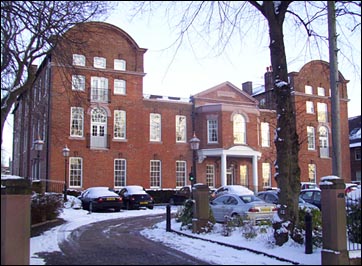 ontinuing
our
stroll
along
City
Walls
Road,
we
soon
come
to
the
distinctive
buildings
of
the former Chester
Royal
Infirmary. ontinuing
our
stroll
along
City
Walls
Road,
we
soon
come
to
the
distinctive
buildings
of
the former Chester
Royal
Infirmary.
The
hospital
finally
closed
in
1993
after
230
years
of
medical
care
on
the
site,
services
were
transferred
to
the Countess
of
Chester
Hospital on
Liverpool
Road
and
the
site
was
sold
for
new
housing. The City Walls Medical Centre remains, however, situated
just behind the old Infirmary on St. Martin's Way.
The
Infirmary
was
founded
as
a
charitable
institution
in
1755
when
it
was
housed
in
the
upper
part
of
the Bluecoat
School,
outside
the Northgate and
the
first
patient
was
one
William
Thompson
of
St.
Mary's
Parish,
who
was
admitted
with
a
wounded
hand
on
November
11th,
1755. Among
Chester's
archives
are
a
complete
record
of
the
names
and
ailments-
including
asthma,
consumption,
jaundice,
dropsy,
scrofula,
scurvy,
worms
and leprosy-
of
every
patient
treated
here,
amongst
which
were
several
cases
of
women
treated
for hysterics.
The
Bluecoat
soon
became
hopelessly
overcrowded,
and so,
in
1761
a
purpose-built
hospital,
designed
to
accomodate
100
patients,
was
erected
upon
open
ground
within
the
city
walls,
a
location
known
as St. Martin
in
the
Fields-
also,
until
the
coming
of
the Inner
Ring
Road,
the
name
of
the
old
road
which
ran
along
the
farther
side
of
the
site.
You
can
still
see
the
date
inscribed
above
the
main
door.
 The
original
medical
staff
comprised
three
physicians
and
three
surgeons.
A
board
of
governors
was
responsible
for
the
admission
and
discharge
of
patients,
and
they
were
also
responsible
for
administration.
The
medical
staff
themselves
also
served
as
governors. The
original
medical
staff
comprised
three
physicians
and
three
surgeons.
A
board
of
governors
was
responsible
for
the
admission
and
discharge
of
patients,
and
they
were
also
responsible
for
administration.
The
medical
staff
themselves
also
served
as
governors.
To
be
admitted
a
patient
had
to
have
a
letter
from
a
subscriber:
a
two
guineas
per
year
subscriber
was
entitled
to
recommend
one
in-patient
and
two
out-patients.
Frequent,
and
often
justified,
may
be
modern
complaints
about
health
service
funding,
but,
in
the
middle
of
the
eighteenth
century,
no
public
money at
all was
provided
for
medical
and
other
social
services
(and
would
not
be
for
the
best
part
of
the
next
two
centuries).
It
was
all
left
to
the
charity
and
benevolence
of
the
well-to-do
and
the
Infirmary
itself
was
supported
entirely by
subscriptions
and
donations, and
there
were
occasions
when
it
was
actually
threatened
with
closure
due
to
lack
of
money. When,
in
September
1780,
the
Infirmary
published
its
accounts,
it
became
clear
that
the
sums
contributed
were
woefully
inadequate
to
maintain
the
standard
of
service
to which they
aspired.
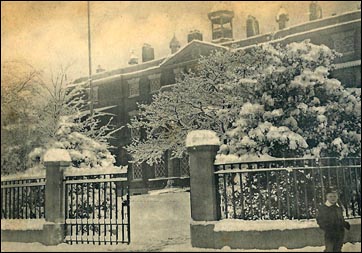 In
Chester itself,
167
subscribers
annually
contributed £288 17s
and
in
the
countryside
43
contributed
£15 4s.
In
North
Wales,
28
people
gave
£73
and
four
subscribers
from
other
surrounding
areas
gave twelve
guineas (£12 12s). In
Chester itself,
167
subscribers
annually
contributed £288 17s
and
in
the
countryside
43
contributed
£15 4s.
In
North
Wales,
28
people
gave
£73
and
four
subscribers
from
other
surrounding
areas
gave twelve
guineas (£12 12s).
Interestingly,
in
the
same
year,
Thomas
Grosvenor
and
William
Bootle
were
re-elected
without
contest
as
Chester's
Members of Parliament
after
regaling
all
comers
with
extravagant
'entertainment'
at
the
principal
inns.
The
money
so
lavished
on political ambition would
doubtlessly have
proved
a
godsend
to
the
cash-strapped
Infirmary.
Nevertheless,
it
was
here
that Dr John
Haygarth, a physician
much
in
advance
of
his
time,
who
served
from
1767-1798,
separated
victims
of
infectious
diseases
such
as
small-pox,
typhus
and
cholera
from
non-infectious
cases.
Amazingly,
this
met
with
opposition
by
some
in
the
medical
profession,
who
saw
it
as
an
'unnecessary'
precaution.
However,
segregation
in
spacious,
airy
wards
and
a regime
of
scrupulous
cleanliness
resulted
in
an
immediate
reduction
in
the
death
rate,
and
Dr.
Haygarth's
practices
were
soon
adopted
elsewhere. In
his
pioneering
experiments
he
was
assisted
by
two
heroic
women, Lowry
Thomas and Jane
Bird,
the
first
fever
nurses
on
record. Using
their
improved
methods,
the
dedicated
staff
also
made
great
progress
in
cutting
the
extremely
high
levels
of
mortality
among
new-born
babies.
You can read the whole of Dr Haygarth's fascinating work, How to Prevent the Small-Pox, written in 1785 at the Hathi Trust's website here.
 The anonymous author of A Walk Round the Walls and City of Chester, published in the first years of the nineteenth century, described the Infirmary so: The anonymous author of A Walk Round the Walls and City of Chester, published in the first years of the nineteenth century, described the Infirmary so:
"The large field on the city side and the open country opposite, render this a fit situation for THE INFIRMARY, which is a handsome pile of building, situate on a pleasant airy spot, on the west side of the city; it was opened on the 17th day of March, 1761, and has been supported by a subscription, and benefactions, that do honour to the city and its environs. The humane attention and care, which the patients receive from the Gentlemen of the faculty, justly entitles them to public thanks. The portrait of Doctor William Stratford, Commissory of the Archdeaconry of Richmond, who was the founder, and left three hundred pounds to the charity, is placed in the council room".
Left: the large area of open ground known anciently as 'Lady Barrow's Hey' and the Infirmary as they appeared on the Chester OS map of 1898. The field may also be seen in the fuzzy photograph below.
Chester
guide
and
author Joseph
Hemingway,
writing
in
1836,
described
the
Infirmary
as "a
most
efficient
establishment
for
the
benevolent
object
for
which
it
was
erected...
it
has
been
the
asylum
and Bethesda of
thousands".
The
records
of
the
years
1755-63
list
the
most
common
ailments
dealt
with
as:
ague,
rheumatism,
fever,
venereal
disease,
abcesses
and
ulcerated
skin,
scurvy,
swollen,
sore
or
painful
limbs,
asthma,
dropsy,
injuries
from
accidents,
consumption
and
tumours.
Also
mentioned
are
hysterical
flatulency,
melancholy,
bloody
flux,
leprosy
and paronchia-
inflammation
of
the
fingernails.
The encouragement of cleanliness
was considered a priority. Paying members of the public were allowed to use the warm slipper bath which was installed at the Infirmary in 1773. The building's enlargement in the 1820s included the provision of two public baths, a free one for dispensary and in-patients and another for paying members of the public- rather wealthy ones, it seems, as admission charges (one shilling in 1811 and two shillings in 1852) excluded all but the wealthiest Cestrians. Both of these offered hot and cold baths, showers and vapour baths.
In 1849, a new complex of washhouses and public baths opened not far away, close to the Water Tower.
In 1790, a sedan chair was purchased in order to transport infirm patients to the Infirmary.
 Despite
the
best
efforts
and
high
standards
of
the
Infirmary
staff,
and
Dr.
Haygarth's
pioneering
work,
18th
century
medicine
was
far
from
an
exact
science
and
'private
practitioners'-
often
little
better
than
quacks-
were
common.
The
medicines
themselves
were
of
variable
quality
and
the
local
press
was
full
of
advertisments
for
dubious
remedies,
including Balsam
of
Licorice- "endued
with
the
most
powerful
pectoral,
healing
and
deterging
qualities"- Hill's
Genuine
Ormskirk
Medicine which "infallably
cures
the
bite
of
a mad
dog",
and Dr.
Greenough's
Tincture
for
the
Preservation
of
Teeth. Despite
the
best
efforts
and
high
standards
of
the
Infirmary
staff,
and
Dr.
Haygarth's
pioneering
work,
18th
century
medicine
was
far
from
an
exact
science
and
'private
practitioners'-
often
little
better
than
quacks-
were
common.
The
medicines
themselves
were
of
variable
quality
and
the
local
press
was
full
of
advertisments
for
dubious
remedies,
including Balsam
of
Licorice- "endued
with
the
most
powerful
pectoral,
healing
and
deterging
qualities"- Hill's
Genuine
Ormskirk
Medicine which "infallably
cures
the
bite
of
a mad
dog",
and Dr.
Greenough's
Tincture
for
the
Preservation
of
Teeth.
Nontheless,
Chester
was
also
one
of
the
first
cities
in
the
country
to
persuade
its
citizens-
initially
much
against
their
will-
to
adopt
the
practise
of
general
inoculation,
as
lately
evolved
by Edward
Jenner.
A public
meeting
at
the
Pentice
(forerunner
of
today's
Town
Hall,
formerly
situated
next
to
St. Peter's
Church)
in
March
1778
led
to
the
formation
of
the Smallpox
Society to
promote
inoculation
of
the
entire
population
at
fixed
periods.
Families
where
the
disease
struck
were
encouraged
to
inform
the
Society's
inspector,
Mr
Owen,
at
once
so
by
isolation
neighbours
would have
a better
chance
of
escaping
infection.
Small
monetary
rewards
were
given
to
those
who
co-operated,
and
the
first,
a sum
of
ten
shillings,
went
to
one
Elizabeth
Brierley,
a poor
woman
of
Sty
Lane,
across
the
river
in
Handbridge.
This
Sty
Lane
was
at
the
time
a "pestifirous
slum
warren",
typical
of
the
places
were
smallpox
was
most
likely
to
take
hold.
The
disease
killed
over
sixty
people
on
average
each
year
in
Chester. "Of
these",
declared
the
Society, "58
might
be
saved
if
all
the
rising
generation
were
inoculated
at
the
same
time.
As
things
are,
smallpox
is
spread
by
sufferers
walking
the
streets.
General
inoculation
would
cost
100
guineas
per
year;
lager
sums
have
been
collected
for
the
relief
of
one
family,
or
even
one
person,
at
our
charitable
assemblies".
 During the Second World War, Chester itself was not badly bombed but was extensively used as a reception centre for wounded and convalescent servicemen. Large houses in the surrounding countryside such as Saighton Grange and Eaton Hall were transformed into military hospitals or convalescent homes. The Infirmary retained its former role as a general hospital and certainly treated some of the wounded from Dunkirk, and procedures were put into place for the treatment of patients during air raids- During the Second World War, Chester itself was not badly bombed but was extensively used as a reception centre for wounded and convalescent servicemen. Large houses in the surrounding countryside such as Saighton Grange and Eaton Hall were transformed into military hospitals or convalescent homes. The Infirmary retained its former role as a general hospital and certainly treated some of the wounded from Dunkirk, and procedures were put into place for the treatment of patients during air raids-
• Stretcher cases were to be admitted to the City Walls entrance, the Ministry of Health to provide
stretcher-bearers to supplement the porters.
• An open shed was to be erected in the drive opposite the City Walls entrance for decontamination purposes.
• Walking cases were to be admitted to the Bedward Row entrance and treated in 'outpatients'.
• Cases of hysteria were the responsibility of the police and ARP staff and were not to be admitted.
In
front
of
the
Infirmary
entrance
there long stood
a curious
column
on
a worn
sandstone
base.
Dr Haygarth, the
Infirmary's
senior
surgeon,
visited
Ireland
around
1893
and
brought
this
piece
of
the
famous Giant's
Causeway-
an
area
of
volcanic
basalt
formed
by
heat
into
six
and
eight-sided
columns-
back
with
him
as
a souvenir-
seemingly a 'stick
of
rock'
with
a difference!
The
base
upon
which
it
was mounted
was
of
rather
greater
local significance,
being
part
of
the
original
base
of
the
ancient Rood
Cross which
stood
for
centuries
on
the Roodee where
another
section
of
the
base
continues
to
stand.
Correspondant Richard
Edkins tells
us
that "Braun's
map
of
Chester shows
an
enclosure
around
the
Roodeye
Cross.
I recalled
from
a visit
to the Infirmary in
1979
that
the
base
had
the
marks
of
four
iron
railings
set
in
lead.
Were
these
the
marks
of
the
enclosure?
The
Infirmary
staff
knew
nothing
about "that
pile
of
bricks
out
front"
and
were
surprised
by
what
I had
to
say.
I was
disappointed
at
being
unable
to
locate
the
references
in
the
archives
that
year".
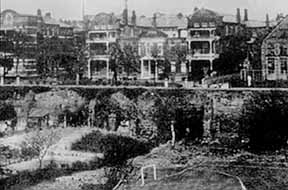 Chester guide Joseph Hemingway however,
writing
in
1835,
stated
that,
in
1811,
the
spire
of Holy
Trinity
Church in Watergate
Street, having
become
unsafe,
was
taken
down
and "the
stones
which
formed
the
summit
of
the
spire,
called
the Rose were
placed
by
Dr.
Thackeray
in
the
Infirmary
garden,
as
a pedestal
for
a basaltic
column
from
the
Giant's
Causeway". Chester guide Joseph Hemingway however,
writing
in
1835,
stated
that,
in
1811,
the
spire
of Holy
Trinity
Church in Watergate
Street, having
become
unsafe,
was
taken
down
and "the
stones
which
formed
the
summit
of
the
spire,
called
the Rose were
placed
by
Dr.
Thackeray
in
the
Infirmary
garden,
as
a pedestal
for
a basaltic
column
from
the
Giant's
Causeway".
Upon
visiting
the
site
to
photograph
this
enigmatic
object,
all
this writer found
was
an
indent
in
the
ground
where
it
had
once
stood.
The
staff
at
the
Grosvenor
Museum
and
the
City
Council
conservation
department
were
quite
unable
to
say
what
has
become
of
it,
and
there
the
matter
rested
until
early
May
1998,
when
emiment
local
historian, Len
Morgan,
accidentally
discovered
it-
standing
in
the
grounds
of
the Countess
of
Chester Hospital! "I
was
just
walking
down
the
hospital
corridor,
saw
it
there
and
could
not
believe
it". Just who was responsible for the thoughtful transfer of the relic to its new home remains a mystery. Mr.
Morgan
offered
to
pay
for
a replacement
sundial,
and
suggested
the
provision
of
an information
plaque.
Above,
we
see
a photograph
of
the
'rediscovered'
sundial
in
its
new
location.
The
original
donor, Dr.
Makepiece
Thackeray,
is
buried
in
the
grounds
of Chester
Cathedral,
and
a memorial
plaque
in
his
honour
may
be
seen
there.
Notice
that
the
narrow
road
on
your
right
between
the Queen's
School and
the
hospital
grounds
bears
the
interesting-
and
seemingly
relevant-
name
of Bedward
Row,
which
actually
derives
from Bereward-
a trainer
of
bears.
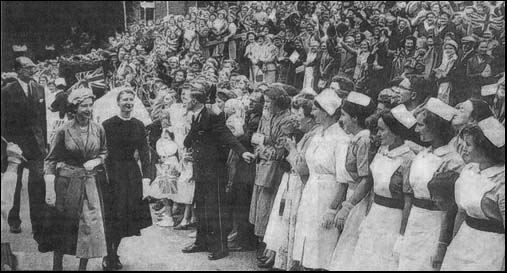 Below
is
a fascinating
view
of
the
infirmary
and
the
Walls
near
it
as
they
appeared
around
the
middle
of
the
19th
century.
Just
beyond
it
you
can
see
the County
Gaol-
built
to
a design by Thomas Harrison to replace
the
medieval Northgate
Gaol,
and
which
stood
here
from
1807-1879
(we learned a little of in our last chapter). Public
executions
were
occasionally
carried
out
on
the
balcony
above
the
main
entrance
and
attracted
large
and
noisy
crowds,
who
gathered
on
the
walls
to
witness
these
events,
often
doubtless
resulting
in
disagreements
with
the
hospital
authorities. Below
is
a fascinating
view
of
the
infirmary
and
the
Walls
near
it
as
they
appeared
around
the
middle
of
the
19th
century.
Just
beyond
it
you
can
see
the County
Gaol-
built
to
a design by Thomas Harrison to replace
the
medieval Northgate
Gaol,
and
which
stood
here
from
1807-1879
(we learned a little of in our last chapter). Public
executions
were
occasionally
carried
out
on
the
balcony
above
the
main
entrance
and
attracted
large
and
noisy
crowds,
who
gathered
on
the
walls
to
witness
these
events,
often
doubtless
resulting
in
disagreements
with
the
hospital
authorities.
Left: the young Queen Elizabeth II visits the Infirmary in 1957.
The
land
upon
which
the
infirmary
stands
was
anciently
known
as Lady
Barrow's
Hey, Hey being
a Saxon
name
for
a field
enclosed
with
hedges. Earlier
still,
the
land
was
used
by
the
Romans
as
a cemetery
and
many
graves
were
uncovered
when
the
hospital
was
being
built
and
enlarged. Chester historian Frank Simpson recorded that, in June 1858, while constructing a railway siding in this field to accomodate exhibitors at the Royal Agricultural Show, the workmen discovered several Roman tombs, which contained such articles as terra-cotta lamps, clay vessels, coins of the period of Domitian, etc.
The City Wall upon which we now stand, to the surprise of many, did not actually exist on this side of the city until the early 12th century- when it was extended by the Normans to enclose this area within the defended circuit. This did not apparently result in any great immediate outburst of urbanisation, however, and most of the great area between the Castle and the North Wall long remained open land- known as The Crofts- and was utilised as smallholdings, gardens and orchards.
In Roman times, the ground on this side of the city west of the present day Inner Ring Road sloped sharply westwards down to the river bank and this slope was eventually cut into three terraces to produce level platforms for buildings and agriculture. The lowest of these terraces was fronted by the massive stone retaining wall which formed the Roman quayside, parts of which may still be seen on the Roodee today. The City Wall was eventually built on top of this lower terrace. The erection of this great wall produced a barrier at the foot of the hillside against which deposits washed down from the slopes above could accumulate, a process that continued from the 12th century right through to fairly recent times. The result is that the entire sloping hillside has disappeared beneath around five metres of accumulated deposits and the ground level we walk on today is now more or less level with the top of the wall. Looking over the parapet opposite the Infirmary at the drop below and the City Wall's great supporting buttresses (clearly visible in the illustration) makes the situation dramatically clear and explains why the walls are so different on this side of the city to those elsewhere in the circuit.
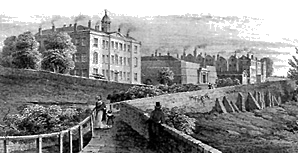 Commencing in the 1150s most of the Crofts came to be occupied by the houses of the religious communities we encountered earlier in our wanderings. Nontheless, much of the land remained unbuilt-upon, serving in its ancient role as the fields and vegetable gardens of the monks and nuns. After the Dissolution of the monasteries in the 1530s, their estates were gradually split up and developed- the final section, Lady Barrow's Hey, as late as 1963, when it was occupied by the modern extension to the Infirmary. Commencing in the 1150s most of the Crofts came to be occupied by the houses of the religious communities we encountered earlier in our wanderings. Nontheless, much of the land remained unbuilt-upon, serving in its ancient role as the fields and vegetable gardens of the monks and nuns. After the Dissolution of the monasteries in the 1530s, their estates were gradually split up and developed- the final section, Lady Barrow's Hey, as late as 1963, when it was occupied by the modern extension to the Infirmary.
Time
and
again,
during
the
middle
ages
and
in
the
Tudor
and
Stuart
periods-
when
the
port
was
at
its
busiest-
Chester
was
scourged
by
the Bubonic
Plague and
many
of
its
victims
were
interred
here,
as
were
the
many
casualties
of
the
Civil
War
Siege of Chester.
In October 1645, towards the end of the siege, the desperate citizens, labouring under heavy fire, threw up a great earthwork here to defend breaches in the rapidly-crumbling city wall. All available citzens, half-starved though they were, were put to the work, including many women, who helped to carry earth in baskets, even though- as a contemporary account states, "The women, like so many valiant Amazons, do out-face death and dare danger, though it lurk in every basket; seven are shot, three slaine, yet they scorn to leave their matchless undertaking, and thus they continue for ten days' space; possessing the beholders that they are immortal".
The attackers stormed into the breaches but the defences held and they were repulsed with heavy losses. The defenders lost 8 or 10 killed including their leader, Sir William Mainwaring, to whom there is a monument in the Cathedral.
Above we can see the area as it appeared on the 1898 OS map and this remarkable
aerial
view-
a
detail
from John
McGahey's famous View
of
Chester
from
a
Balloon- shows
the
Infirmary
and
its
surroundings
as
they
appeared
around
the
year
1855.
 In
July
1998,
the
ugly
modern
buildings
(photographed below)
that
had been erected in 1963 to enlarge
the
18th
century
Infirmary
were
removed,
and,
amidst
the demolition,
a
team
of
Chester's
archaeologists under the direction of Mike Emery undertook
an
investigation
of
the
site.
The
remains
of
some
interesting-
and
previously
unknown-
Roman
and
Saxon
buildings,
a
well-preserved
medieval
road
and
a
17th
century
pipe
kiln-
the
oldest
yet
found
in
Britain-
were
uncovered. Notice
how
these
modern
structures
are
set
into
a
'well'
in
the
ground.
This
method
of
construction
unfortunately
ensured
the
efficient
destruction
of
all
traces
of
ancient
remains. In
July
1998,
the
ugly
modern
buildings
(photographed below)
that
had been erected in 1963 to enlarge
the
18th
century
Infirmary
were
removed,
and,
amidst
the demolition,
a
team
of
Chester's
archaeologists under the direction of Mike Emery undertook
an
investigation
of
the
site.
The
remains
of
some
interesting-
and
previously
unknown-
Roman
and
Saxon
buildings,
a
well-preserved
medieval
road
and
a
17th
century
pipe
kiln-
the
oldest
yet
found
in
Britain-
were
uncovered. Notice
how
these
modern
structures
are
set
into
a
'well'
in
the
ground.
This
method
of
construction
unfortunately
ensured
the
efficient
destruction
of
all
traces
of
ancient
remains.
Right: the Infirmary as it appeared in the mid-1960s; the 1761 building is on the far right and the extensions dating from 1913 closest to the camera. These have now entirely vanished and new housing stands on their site.
(This
writer
made
a
detailed photographic
record
of
the project- including interior studies of the hospital buildings, their demolition, the
archaeologist's
work and the construction of the new houses-
which
is
available
for inspection to
interested
readers).
But
at
least
the
original
1761
Infirmary-
a
grade
II
listed
building-
has
been
fully
restored
to
form
an
integral
part
of
the
new
housing
development,
and
its
interior
sub-divided
into
18
'executive
apartments'.
We
first saw
the
restored building
floodlit
at
night
in
October
2001,
just
after
the
scaffolding
had
come
down,
and
must
say
it
looked
magnificent.
You
can
read
more
about
this
site
and
see
an
'artist's
impression'
of
the
new
houses
which
have
been
built
there-
when
we
reach St. Martin's
Gate. In addition, here is an illustrated history of the hospitals in and around Chester and here is a fascinating short British Pathé newsreel from 1939 of the Bishop of Chester, Doctor Fisher, helping to carry a barrel organ through the streets, aided by others and playing the instrument to raise money for the infirmary. This film records the visit to Chester of Queen Elizabeth and Prince Philip in 1957 and, as well as scenes such as the opening of County Hall, includes a short sequence of them touring the Infirmary.
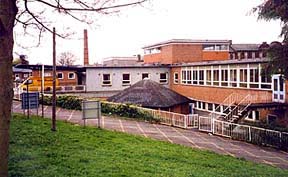 • Reader Wilf Burgess wrote to tell us, "I am a retired nurse teacher attempting to find personal recollections of nurses who trained and worked in Chester, particularly at the Chester Royal Infirmary from 1920 onward. My current interest is because I am developing a website about the history of our Schools of Nursing- Chester will be a center piece. But of course the real history can only come from the personal experience of people who were there in some role- nurses or patients. I just hope that some will assist. Any contributions will be gratefully received". • Reader Wilf Burgess wrote to tell us, "I am a retired nurse teacher attempting to find personal recollections of nurses who trained and worked in Chester, particularly at the Chester Royal Infirmary from 1920 onward. My current interest is because I am developing a website about the history of our Schools of Nursing- Chester will be a center piece. But of course the real history can only come from the personal experience of people who were there in some role- nurses or patients. I just hope that some will assist. Any contributions will be gratefully received".
If you can assist Wilf, email him.
Moving
on,
we
see
the
roadway
curving
round
sharply
to
the
right.
Before
the
coming
of
the
Inner
Ringroad
in
the
1960s,
this
was
the
commencement
of Water
Tower
Street,
which
ran
the
full
length
of
the
North
Wall
as
far
as
the Northgate.
Since
being
cut
in
two
by
St.
Martin's
Way,
this
section
has
been
counted
as
forming
part
of City
Walls
Road.
The
footpath
at
this
point
temporarily
parts
company
with
the
road
and
continues
straight
on
up
a
slight
incline-
the
course
we
will
now
be
taking.
The Railway
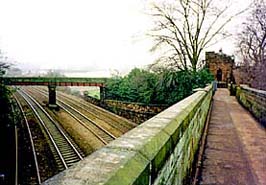 As
we
proceeded
along
the
side
of
the Roodee,
you
may
have
heard
the
sound
of
passing
trains
and
saw
the
long
line
of
arches
forming
the
railway
viaduct
approaching
closer
and
closer
until,
as
we
enter
this
slight
incline
in
the
wall,
we
see
to
our
surprise
the
railway
line
passing
right
beneath
us!
As
we
look
to
our
right,
we
see
it
cut
through
the
facing
corner
of
the
walls
before
making
its
way
between
North
Wales
and
Chester
Station
and
beyond. As
we
proceeded
along
the
side
of
the Roodee,
you
may
have
heard
the
sound
of
passing
trains
and
saw
the
long
line
of
arches
forming
the
railway
viaduct
approaching
closer
and
closer
until,
as
we
enter
this
slight
incline
in
the
wall,
we
see
to
our
surprise
the
railway
line
passing
right
beneath
us!
As
we
look
to
our
right,
we
see
it
cut
through
the
facing
corner
of
the
walls
before
making
its
way
between
North
Wales
and
Chester
Station
and
beyond.
Thomas
Hughes,
in
his Stranger's
Handbook
to
Chester,
published
in
1856,
wrote, "We
are
now
upon
a
flat
iron
bridge,
and
whew!
with
a
rush
like
that
of
a
tiger
from
his
den,
the
giant
of
the
nineteenth
century-
a
steam
engine
and
train-
emerge
from
the
dark
tunnel
which
passes
under
the
city,
and
dash
away
beneath
us,
full
fourty
miles
an
hour,
en
route to
Ireland,
by
way
of
Holyhead.
The
Roman
walls,
that
resisted
so
successfully
the
Roundhead
batteries,
have
in
our
own
time
succumbed
to
the
engines
of
peace,
and
the
railway
trains,
with
their
living
freight,
now
career
it
merrily
through
two
neighbouring
apertures
in
these
ancient
fortifications".
The
line
had
been
constructed
just
ten
years
earlier,
in
1846,
originally
to
run
between
Chester
and
Ruabon,
and
to
this
day
is
the
main
line
into
North
Wales.
We
will
learn
a
little
more
of
Chester's
railways
in
our
next
chapter. Our
photograph
clearly
shows
the
right-angle
of
the
wall,
the
further
section
a
slender
elevated
walkway-
though
it
seemed
very
solid
and
wall-like
when
we
passed
over
it-
with
the
railway
lines
passing
beneath...
Here is our growing gallery of old photographs of the Chester Royal Infirmary.
We
have
now arrived
at
the
north west
corner
of
the
City
Walls
and
here
encounter
a
couple
of
very
remarkable
old towers...
Curiosities from Chester's History no. 24
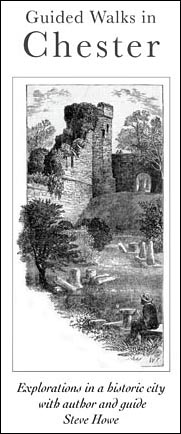 1732 The River Dee Company formed by Mr Nathaniel Kinderley and others. A new channel was cut which reclaimed land on the eastern margin of the river. 1732 The River Dee Company formed by Mr Nathaniel Kinderley and others. A new channel was cut which reclaimed land on the eastern margin of the river.
- 1736 By an Act of Parliament, the New River was cut through a large area of white sand- the old course of the Dee by now being so choked up that no vessels could approach within four miles of the city.
- 1741 George Frideric Handel (1685-1759) stayed at the Golden Falcon in Northgate Street on his way to Ireland, and conducted rehersals of his new (and now best-known) work, Messiah.
- 1745 Charles Edward Stuart, the 'Young Pretender' lands in Scotland and defeats English army at Prestonpans; marches south but is forced to retreat at Derby. Fears that the Stuart rebels marching under 'Bonnie Prince Charlie' might attack Chester led to many precautions being taken: the Watergate, Northgate and Sally-Ports walled up, several buildings ajoining the walls were pulled down, and householders were ordered to buy in 2 week's provisions, in case of siege. Great panic ensued, but the city was by-passed by the rebels, who marched on into Staffordshire. When Charles retreated with his army, a large number of these rebels were "brought in 16 carts prisoners to the Castle, which being thus filled, the Spring Assizes were held at Flookersbrook (close to where these words are being written), and "the whole of the court's time was devoted to their trial".
- 1746 The 'Young Pretender' wins a victory at Falkirk but is finally defeated at Culloden; with the help of Flora MacDonald he escapes to France. The wearing of tartan is forbidden throughout Great Britain.
- 1750 Two Irishmen, Garrat Delaney and Edward Johnson, were, upon the evidence of their accomplice, John Caffery, executed at Boughton and gibbetted (hung in chains) on the Parkgate Road for the murder and robbery of their companion, Brian Molloy, "which, it is to be hoped, will be a terror and warning to their countrymen, who have of late committed many villianies in that part of the County". Also at the Assizes, John Ketle, for feloniously driving away three sheep, the property of
Sir Henry Mainwaring Bart., received the sentence of death but was reprieved before the Judge left the city, in order for transportation. Also John Looker and Richard Looker, two brothers, for stealing several silver spoons, were ordered for transportation.
- 1752 Great Britain adopts the Gregorian
calendar on Sept 14th (Sept 3-13th were omitted, leading to riots by people
believing they had been robbed of ten days)
- 1754 The Mayor of Chester, Dr Cowper, refused to take part in the Bull Bait at the High Cross, and ordered the Corporation to do likewise. He also cancelled the Venison Feasts- at which up to 40 haunches may be consumed- previously enjoyed by them. The 'New Cut' of the River Dee from Parkgate to Chester completed. Building of nos 3-11 Abbey Square commenced.
- 1755 The Infirmary (see above) was founded this year, initially housed in the Bluecoat School. The Lisbon earthquake kills 30,000 people
- 1760 King George II dies; succeeded by his grandson George III (1738-1820). Kew Gardens in London opened.
- 1761 The Infirmary (see above) in City Walls Road was built. The Bridgewater Canal, between Liverpool and Leeds, was opened.
- 1762 This year, a "new machine" with "six able horses" would depart from the Golden Talbot (now the Grosvenor Hotel in Eastgate Street) for the Woodside boat house (Birkenhead) on Tuesdays, Thursdays and Saturdays at 8am, returning the same day at 4pm.
|


 ontinuing
our
stroll
along
City
Walls
Road,
we
soon
come
to
the
distinctive
buildings
of
the former Chester
Royal
Infirmary.
ontinuing
our
stroll
along
City
Walls
Road,
we
soon
come
to
the
distinctive
buildings
of
the former Chester
Royal
Infirmary. The
original
medical
staff
comprised
three
physicians
and
three
surgeons.
A
board
of
governors
was
responsible
for
the
admission
and
discharge
of
patients,
and
they
were
also
responsible
for
administration.
The
medical
staff
themselves
also
served
as
governors.
The
original
medical
staff
comprised
three
physicians
and
three
surgeons.
A
board
of
governors
was
responsible
for
the
admission
and
discharge
of
patients,
and
they
were
also
responsible
for
administration.
The
medical
staff
themselves
also
served
as
governors.  In
Chester itself,
167
subscribers
annually
contributed £288 17s
and
in
the
countryside
43
contributed
£15 4s.
In
North
Wales,
28
people
gave
£73
and
four
subscribers
from
other
surrounding
areas
gave twelve
guineas (£12 12s).
In
Chester itself,
167
subscribers
annually
contributed £288 17s
and
in
the
countryside
43
contributed
£15 4s.
In
North
Wales,
28
people
gave
£73
and
four
subscribers
from
other
surrounding
areas
gave twelve
guineas (£12 12s). As
we
proceeded
along
the
side
of
the Roodee,
you
may
have
heard
the
sound
of
passing
trains
and
saw
the
long
line
of
arches
forming
the
railway
viaduct
approaching
closer
and
closer
until,
as
we
enter
this
slight
incline
in
the
wall,
we
see
to
our
surprise
the
railway
line
passing
right
beneath
us!
As
we
look
to
our
right,
we
see
it
cut
through
the
facing
corner
of
the
walls
before
making
its
way
between
North
Wales
and
Chester
Station
and
beyond.
As
we
proceeded
along
the
side
of
the Roodee,
you
may
have
heard
the
sound
of
passing
trains
and
saw
the
long
line
of
arches
forming
the
railway
viaduct
approaching
closer
and
closer
until,
as
we
enter
this
slight
incline
in
the
wall,
we
see
to
our
surprise
the
railway
line
passing
right
beneath
us!
As
we
look
to
our
right,
we
see
it
cut
through
the
facing
corner
of
the
walls
before
making
its
way
between
North
Wales
and
Chester
Station
and
beyond. 

 Despite
the
best
efforts
and
high
standards
of
the
Infirmary
staff,
and
Dr.
Haygarth's
pioneering
work,
18th
century
medicine
was
far
from
an
exact
science
and
'private
practitioners'-
often
little
better
than
quacks-
were
common.
The
medicines
themselves
were
of
variable
quality
and
the
local
press
was
full
of
advertisments
for
dubious
remedies,
including Balsam
of
Licorice- "endued
with
the
most
powerful
pectoral,
healing
and
deterging
qualities"- Hill's
Genuine
Ormskirk
Medicine which "infallably
cures
the
bite
of
a mad
dog",
and Dr.
Greenough's
Tincture
for
the
Preservation
of
Teeth.
Despite
the
best
efforts
and
high
standards
of
the
Infirmary
staff,
and
Dr.
Haygarth's
pioneering
work,
18th
century
medicine
was
far
from
an
exact
science
and
'private
practitioners'-
often
little
better
than
quacks-
were
common.
The
medicines
themselves
were
of
variable
quality
and
the
local
press
was
full
of
advertisments
for
dubious
remedies,
including Balsam
of
Licorice- "endued
with
the
most
powerful
pectoral,
healing
and
deterging
qualities"- Hill's
Genuine
Ormskirk
Medicine which "infallably
cures
the
bite
of
a mad
dog",
and Dr.
Greenough's
Tincture
for
the
Preservation
of
Teeth. During the Second World War, Chester itself was not badly bombed but was extensively used as a reception centre for wounded and convalescent servicemen. Large houses in the surrounding countryside such as Saighton Grange and Eaton Hall were transformed into military hospitals or convalescent homes. The Infirmary retained its former role as a general hospital and certainly treated some of the wounded from Dunkirk, and procedures were put into place for the treatment of patients during air raids-
During the Second World War, Chester itself was not badly bombed but was extensively used as a reception centre for wounded and convalescent servicemen. Large houses in the surrounding countryside such as Saighton Grange and Eaton Hall were transformed into military hospitals or convalescent homes. The Infirmary retained its former role as a general hospital and certainly treated some of the wounded from Dunkirk, and procedures were put into place for the treatment of patients during air raids- Chester guide Joseph Hemingway however,
writing
in
1835,
stated
that,
in
1811,
the
spire
of Holy
Trinity
Church in
Chester guide Joseph Hemingway however,
writing
in
1835,
stated
that,
in
1811,
the
spire
of Holy
Trinity
Church in  Below
is
a fascinating
view
of
the
infirmary
and
the
Walls
near
it
as
they
appeared
around
the
middle
of
the
19th
century.
Just
beyond
it
you
can
see
the County
Gaol-
built
to
a design by Thomas Harrison to replace
the
medieval
Below
is
a fascinating
view
of
the
infirmary
and
the
Walls
near
it
as
they
appeared
around
the
middle
of
the
19th
century.
Just
beyond
it
you
can
see
the County
Gaol-
built
to
a design by Thomas Harrison to replace
the
medieval  Commencing in the 1150s most of the Crofts came to be occupied by the houses of the religious communities we encountered earlier in our wanderings. Nontheless, much of the land remained unbuilt-upon, serving in its ancient role as the fields and vegetable gardens of the monks and nuns. After the Dissolution of the monasteries in the 1530s, their estates were gradually split up and developed- the final section, Lady Barrow's Hey, as late as 1963, when it was occupied by the modern extension to the Infirmary.
Commencing in the 1150s most of the Crofts came to be occupied by the houses of the religious communities we encountered earlier in our wanderings. Nontheless, much of the land remained unbuilt-upon, serving in its ancient role as the fields and vegetable gardens of the monks and nuns. After the Dissolution of the monasteries in the 1530s, their estates were gradually split up and developed- the final section, Lady Barrow's Hey, as late as 1963, when it was occupied by the modern extension to the Infirmary. In
July
1998,
the
ugly
modern
buildings
(photographed below)
that
had been erected in 1963 to enlarge
the
18th
century
Infirmary
were
removed,
and,
amidst
the
In
July
1998,
the
ugly
modern
buildings
(photographed below)
that
had been erected in 1963 to enlarge
the
18th
century
Infirmary
were
removed,
and,
amidst
the  • Reader Wilf Burgess wrote to tell us, "I am a retired nurse teacher attempting to find personal recollections of nurses who trained and worked in Chester, particularly at the Chester Royal Infirmary from 1920 onward. My current interest is because I am developing a website about the history of our Schools of Nursing- Chester will be a center piece. But of course the real history can only come from the personal experience of people who were there in some role- nurses or patients. I just hope that some will assist. Any contributions will be gratefully received".
• Reader Wilf Burgess wrote to tell us, "I am a retired nurse teacher attempting to find personal recollections of nurses who trained and worked in Chester, particularly at the Chester Royal Infirmary from 1920 onward. My current interest is because I am developing a website about the history of our Schools of Nursing- Chester will be a center piece. But of course the real history can only come from the personal experience of people who were there in some role- nurses or patients. I just hope that some will assist. Any contributions will be gratefully received". 